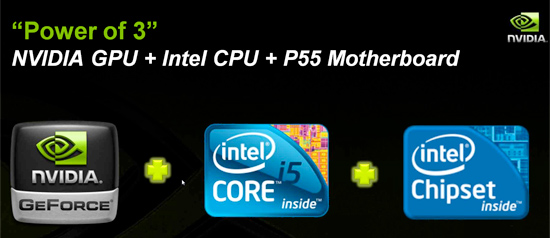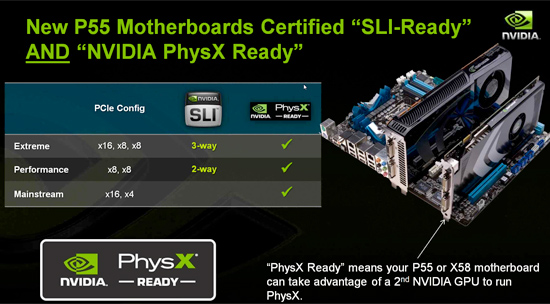Preparing for P55: Motherboards, Memory and NVIDIA
by Anand Lal Shimpi on August 20, 2009 4:00 PM EST- Posted in
- Motherboards
NVIDIA and P55
Yesterday NVIDIA held its Power of 3 platform briefing. The intention was to align NVIDIA’s GPUs, SLI and PhysX with the Intel Lynnfield/P55 launch. NVIDIA has no Lynnfield chipsets out (but is expected to sometime next year), instead it is providing SLI licenses to those motherboard makers that are interested in supporting multi-GPU on their boards.

The license terms are thankfully a lot more palatable than they were with the initial X58 launch. To support SLI a motherboard manufacturer simply has to pay NVIDIA $30,000 up front plus $3 per SLI enabled motherboard sold. In turn NVIDIA gives the motherboard manufacturer a key to put in its BIOS that tells the NVIDIA display drivers that it’s ok to enable SLI on that platform.
As I’ve mentioned in the past, Lynnfield includes an on-die PCIe controller provided 16 PCIe 2.0 lanes. Using an external switch those 16 lanes can be split off into two x8 slots, enabling CF and SLI (CF is enabled free of charge, SLI requires participation in the licensing program).
Although unnecessary, if you want the bandwidth of two x16 PCIe 2.0 slots the motherboard manufacturer will need to use an nForce 200 chip. This chip houses 32 PCIe 2.0 lanes but connects to the Lynnfield chip via 16 lanes, so you get better bandwidth between cards but no increase in bandwidth between the GPUs and the CPU. Expect boards that use an nForce 200 chip to be limited at best.
Without the PCIe switch logic to split the x16 connection off of Lynnfield into two x8 connections, SLI can’t be enabled; NVIDIA won’t allow it over mismatched PCIe slots (e.g. x16 + x4).
In an unexpected alignment, NVIDIA is actually calling out AMD’s Dragon platform by name (Phenom II + AMD 700 Series Chipset + AMD 4800 Series GPU). NVIDIA calls its “platform” the Power of 3, of course referring to Intel’s P55, Intel’s Lynnfield and a NVIDIA GPU. Intel gets it for free here; NVIDIA does all of the branding and promotion for Power of 3, yet Intel makes the vast majority of the silicon. Perhaps someone is bitter over not being included in AMD’s platform launch plans anymore?
All kidding aside, at least this means we will see mature driver and SLI support for Lynnfield at launch. While NVIDIA was in good shape when X58 debuted last year, AMD’s driver support left much to be desired. It’s clear that even NVIDIA with its anti-Intel blood sees the importance of Lynnfield; it’s nice to see egos checked at the door.

There’s one more logo program that’s being introduced with Lynnfield SLI certification: PhysX Ready. Yep, you read that right. NVIDIA is now allowing motherboard makers who are SLI partners to put a PhysX Ready logo on their boxes if they have enough PCIe slots to support a second GPU as a PhysX card.

You may remember that we weren’t overly impressed with PhysX the last time we looked at it, but NVIDIA promises that the use of PhysX in Batman: Arkham Asylum is beyond anything we’ve ever seen. We’ll find out next month when Batman ships.










59 Comments
View All Comments
strikeback03 - Tuesday, August 25, 2009 - link
What does uATX have to do with sexy desktops?araczynski - Tuesday, August 25, 2009 - link
...i immediately thought of an impotent old man yelling "I can almost get it up!"ClagMaster - Sunday, August 23, 2009 - link
One feature that would be welcome (at least for me) with the Lynnfield/P55 is the option to run unbuffered ECC memory. With memory sizes pushing 16GB using DDR3 memory with smaller memory cells, lower voltages, higher operating frequencies, I expect (sooner or later) memory parity errors will eventually become a emergent problem with desktop systems.Memory parity errors arise from memory cells loosing their charges from alpha particle interactions from radioactive decay of uranium or thorium impurities within the silicon, or energetic cosmic ray interactions. This lost bit causes data corruption that ECC can detect and fix.
I remember seeing a white paper from the Corsair Website a few years ago that claimed a 256MB stick of DDR memory experienced about ~3 memory parity error events per month. At that rate, 16GB would be equivalent to 19 parity error events each month. If you really need that amount of memory for a 64-bit system for running applications, then the probablity is greater for fatal errors which cause BSD's, or even worse, non-fatal errors that corrupt data.
I would not be surprised ECC memory soon becoming popular with desktop systems.
tajmahal - Friday, August 21, 2009 - link
Since these CPUs and motherboards have been out for retail sale in Taiwan for over a week now and in AU for a few days, does anyone have any benchmark links? Too bad AT and other sites signed up with Intels NDA and then got screwed by them with their mass release of the i5 and i7 LGA1156 CPUs. I can only find a few links in ATs forums and other forums.ComputerGuy2006 - Friday, August 21, 2009 - link
Gigabyte GA-P55-UD6 looks interesting... 10 sata ports (4 of them 6GB) along with (apaprently) 2 eSata ports.papapapapapapapababy - Friday, August 21, 2009 - link
call me when there is a game that uses 5% of all this power.(EFFICIENTLY) i dont mean super h res console crap.
where the hell is the next cryteck?
iwodo - Thursday, August 20, 2009 - link
Do games still need to be specially written in Driver to get it properly supported?jordanclock - Friday, August 21, 2009 - link
That hasn't been an issue since about a month or two after SLI debuted. You can create an SLI profile for just about any game, and most of the time receive a large performance boost if you were GPU limited with one card. I don't know why you were under the impression that games have to be added to the driver to be "properly supported," as you put it.davekozy - Thursday, August 20, 2009 - link
PCIE 2 8x is fast enough for GTX 285 and 4890 but does limit 4870x2 and 295 a little. Going forward this limit will be more important with 300 and 5000 series cards. So it might not matter much today but in a few months this will be a bigger concern.SLI works on my P6T with the slots 16,16,4. The statement that Nvidia doesn't allow SLI with mismatched PCIE speeds is not correct. I think it's more the slow connection to the P55 chipset through the 4x slot that they're worried about and therefore not allowing SLI on these configurations. If customers buy a second card for SLI and get little increase then they might not try it again. AMD looks to follow suit according to the article.
snakeoil - Thursday, August 20, 2009 - link
the crippled intel lynfield offers nothing new its just a crippled core i7 at the same price.annandtech anaunces this fantastic progress but this is a farce, intel reducing costs and the intel user getting less at the same price.